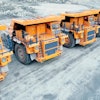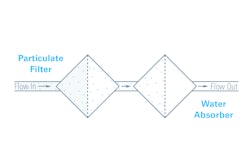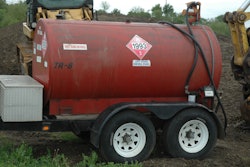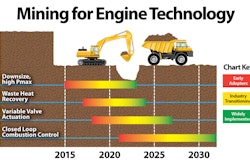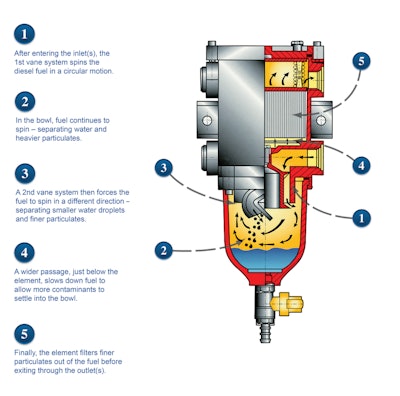
A properly designed fuel filter prevents water or particles that may be in fuel from entering a vehicle’s fuel system and engine. Small pieces of dirt or dust that don’t get filtered out of the fuel can get stuck in the openings of injectors, causing decreased engine performance or system malfunctions. Ted Loftis, director of engineering at Cummins Filtration, says clean fuel enables an engine to consistently operate at its designed efficiency, emissions and economy targets during its lifetime.
Fuel cleanliness has become increasingly important within recent years due in part to the implementation of Tier 4 engines. Because these engines work at higher pressures and have smaller injector openings, even the smallest amount of water or particulate can cause the engine to underperform.
According to Karl Thomas, product manager for fuel filtration, Schroeder Industries, fuel for Tier 4 engines has to be 100 times cleaner than the fuel used in Tier 3 engines. Where Tier 3 diesel engines can operate with between 1,300 and 2,500 particles greater than 4 microns in the fuel, Tier 4 engines can only have between 20 and 40 particles greater than 4 microns entering the engine. “The cleaner the fuel, the more efficient it will burn,” he says. “And the better it burns, the better the engine performs.”
New fuel cleanliness standards are now being implemented to guide filter design in order to meet the needs of Tier 4 engines.
Water and particulate removal
Along with having to capture an increased amount of particulate due to smaller injector openings, fuel filters must now be able to prevent subvisible particulate from entering the engine. Fuel filters need to remove particulate in the 1- to 5-micron range (about the size of a red blood cell), whereas 20 years ago, particulate removal was in the 50-micron range (the human eye can see 40 microns and above).
“We need to make sure the particulate removal is happening before it hits the pump or injector because it’s been shown that even sub 10-micron particles can wear on a high-injection fuel pump... and clog [openings] of the injectors,” says Tom Muzik, global engineering manager, Parker Velcon Filtration Division.
To capture larger amounts of microscopic particulate, fuel filter manufacturers have been working to develop new types of filtration media. While traditionally fuel filters have used cellulose and cellulose-blended media to remove solid particulate, this media type is no longer able to meet the contaminant removal needs of newer engines. “Inert inorganic bonded fixed pore fibers are needed to capture finer particulate, plus maintain a reasonable element life,” says Tim Mills, product manager, Kaydon Filtration.
In early 2013, Cummins Filtration introduced its latest filtration media, NanoNet, which uses smaller fibers to enhance a filter’s ability to capture subvisible particulates. “Smaller fibers provide higher efficiency to capture smaller particles while providing a greater [holding] capacity for contaminants,” says Neha Takawale, global product manager at Cummins Filtration. Takawale further explains that the NanoNet fuel filters have seven to 13 times greater retention of harmful particles within the filtration media during engine vibration and fuel surge. This high retention rate ensures particles don’t slip through the filter or get knocked loose and make their way into the fuel, engine or other vehicle systems.
With engines working at higher pressures — 15,000 psi and above — removing water from fuel is essential to maintaining the performance of an engine. While just 20 years ago engines were able to burn water that entered the fuel system, now even the smallest amount of water can cause an injector tip to blow and the engine to need overhauling, says Dan Bigelow, chief operating officer at Separ Filter. “We’re at an interesting point where it is more important today to have quality filtration on the equipment to protect the engine than we ever have before,” he adds.
For water removal, many filter manufacturers will use an absorbent technology to literally absorb water from the fuel. Once the absorbent can no longer absorb and hold water, the filter must be replaced. The Aquacon diesel filters from Parker Velcon use an absorbent technology called Super Absorbing Polymer, which is in the same family of chemical products as diapers. “It actually chemically bonds the water to a polymer and it’s no longer water at that point,” says Muzik.
In conjunction with more absorbent filtration media, water separators and coalescers can be used to further enhance water and particulate removal. The SWK-2000 Series of fuel water separators from Separ Filter, for example, use five stages of filtration to separate water and the majority of particles prior to the fuel passing through the filter media. Coalescers, on the other hand, continually remove water by gathering droplets of water from the fuel and dropping them into a sump. Unlike an absorbent, which requires users to replace the filter once it is no longer able to absorb and hold water, coalescers have a sump that needs to be drained on a periodic basis.
“Effectively, customers can have continuous operation of [a] filter system without having to change elements due to water,” says Thomas.
Changes in fuel
Though fuel quality has improved within recent years, there are still many places around the globe where fuel quality is questionable. According to Loftis, 50% of the world’s fuel supply does not meet current ISO fuel cleanliness standards.
“In many of our field experiences [we] have seen fuel samples 30 times dirtier than the ISO 18/16/13 specified by the fuel injection equipment manufacturers,” adds Barry Verdgan, research fellow at Cummins Filtration. ISO 18/16/13 states no more than between 1,300 to 2,500 particles greater than 4 micron can be present in the fuel.
Some fuel suppliers have also been known to dilute their diesel fuel with water in order to trick customers into thinking they’ve received more fuel than they actually have. Because of practices like this, Muzik notes the importance of filtering fuel before it enters a vehicle in addition to using onboard fuel filtration systems.
Along with poor fuel quality, filter manufacturers have had to contend with the introduction of biofuels and ultra low sulfur diesel (ULSD).
Biofuel is challenging because it is hygroscopic, which means it attracts water into the fuel. “It’s actually like a magnet and it pulls water [in] from the atmosphere and surroundings,” says Bigelow.
As biodiesel grades increase, so does the aggressiveness of those fluids, requiring different metallurgy and filter media binders to be used in fuel filters. For example, Bigelow notes that Separ Filters had to change the type of materials used in the O-rings, seals and other components in its filtration systems to ensure compatibility with up to B100 biodiesel.
Poor quality biofuels can also be an issue, notes Muzik. If a biofuel is not refined properly, a byproduct called glycerin will become present in the fuel. Glycerin is basically the same thing as soap, and it will coat fuel filters as well as potentially deactivate coalescers, inhibiting their ability to remove water from the fuel. Muzik says this was more of an issue in the past. “ [People] are being more diligent in specifying the quality of the biofuel they’re putting into their engines,” he states.
With ULSD, water removal is also a challenge because the chemistry of the fuel changed from the previous low sulfur version of diesel. ULSD contains 15 parts per million (ppm) of sulfur, whereas low sulfur diesel contains 500 ppm. According to Thomas, the change in fuel chemistry changed the surface tension of the diesel and made it harder to get water out of the fuel.
Challenges with ULSD can also arise from the additives used in them. Verdgan says some blends use additives that can precipitate out as soaps when metal ions are present, causing injector sticking and, in extreme cases, plugged filters.
Filtration demands will increase
As engine technologies continue to progress, many engine manufacturers foresee injection pressures doubling again, causing injector openings to decrease in size even more. This will further emphasize the need to have cleaner fuels running through a vehicle.
Muzik believes fuel filtration is only going to grow in importance over the coming years to ensure engines run smoothly and efficiently. “[Engine manufacturers are] not going to get their technology for a more efficient diesel engine without filtration,” he states. “It’s going to be an integral part of the process.”



